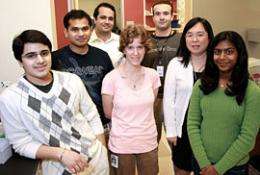Bacteria as an environmental sensor

(PhysOrg.com) -- A UT Dallas student team has harnessed common bacteria to quickly detect the presence of potentially hazardous petrochemicals in water or seafood.
Acting in the wake of the Deepwater Horizon well that spewed 4.9 million barrels of crude oil into the Gulf of Mexico last summer, the students have created sensors that produce a fluorescent protein when they test positive for several petrochemicals.
The sensors could ultimately have important practical applications, enabling cleanup personnel to inexpensively detect contaminants on-site rather than having to wait for lab results, said one of the team’s faculty advisers.
The team, which consisted of high school, undergraduate and graduate students, used standard molecular biology tools to reprogram a harmless strain of E. coli to glow when exposed to certain pollutants. Those pollutants are associated with a host of health risks, including cancer, heart damage, liver damage and kidney failure, according to the United Nations World Water Assessment Program.
“Many of these chemicals are persistent contaminants that circulate through the environment, polluting water supplies and marine ecosystems for extended periods of time,” the students explained in their project materials. “We have developed novel modular biosensors that enable cheap on-site detection of these chemicals using Escherichia coli.”
Venturing into the quickly evolving field of synthetic biology, the students took their results to the Massachusetts Institute of Technology, where more than 100 student teams recently participated in iGEM, the International Genetically Engineered Machine competition. In this debut year, the UT Dallas team received a non-competitive gold medal for the quality of their work.
The iGEM teams were at work for months before the competition, starting when they each received a standard biological toolkit to use. Each team strove to build biological systems that operate in living cells in ways that produce benefits in areas such as medicine, energy production or environmental science.
“Synthetic biology borrows a lot of ideas from engineering and puts them in the context of biology,” said Dr. Leonidas Bleris, an assistant professor of electrical engineering who advised the team along with Dr. Hyun-Joo Nam, an assistant professor of bioengineering (both of the Erik Jonsson School of Engineering and Computer Science).
It was the first UT Dallas team to participate in the 7-year-old annual competition, but it probably won’t be the last, Bleris said. It hasn’t been decided yet, however, whether next year’s team will build on this year’s project or venture in some other direction.
“That will be up to the students to decide,” he said.
Provided by University of Texas at Dallas












.jpg)





